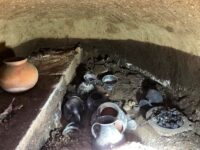 An intact tomb from the 6th century B.C. has been discovered in the Etruscan necropolis of Casale dell’Osteria in Vulci in Lazio, central Italy. The 2,500-year-old tomb is richly furnished with pottery and contains an incredibly rare final meal on a brazier.
An intact tomb from the 6th century B.C. has been discovered in the Etruscan necropolis of Casale dell’Osteria in Vulci in Lazio, central Italy. The 2,500-year-old tomb is richly furnished with pottery and contains an incredibly rare final meal on a brazier.
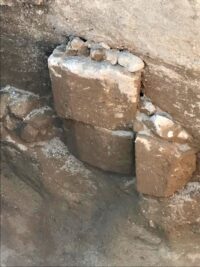 Archaeologists with the Vulci Foundation made the discovery earlier this month when the excavation revealed two tufa stone slabs two feet wide and weighing 40 kilos (88 lbs) in place in front of the entrance to the tomb. The team used a crane to carefully remove the slabs and uncover the entrance. Inside, they found a chamber tomb with a rock-cut platform and an array of about 30 vessels, mostly black bucchero pottery, cups, glass unguentaria and amphorae, all intact and in impeccable condition.
Archaeologists with the Vulci Foundation made the discovery earlier this month when the excavation revealed two tufa stone slabs two feet wide and weighing 40 kilos (88 lbs) in place in front of the entrance to the tomb. The team used a crane to carefully remove the slabs and uncover the entrance. Inside, they found a chamber tomb with a rock-cut platform and an array of about 30 vessels, mostly black bucchero pottery, cups, glass unguentaria and amphorae, all intact and in impeccable condition.
On the right side of the chamber towards the entrance is a bronze brazier still containing the coals and 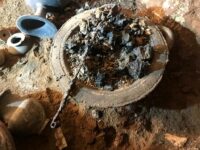 the skewers that held the meat cooked for the final repast. The cinerary remains of the tomb’s owner were placed inside an olla — a squat, rounded pot commonly used by the Etruscans as containers for the entombment of cremated remains — on top of the rock-cut platform.
the skewers that held the meat cooked for the final repast. The cinerary remains of the tomb’s owner were placed inside an olla — a squat, rounded pot commonly used by the Etruscans as containers for the entombment of cremated remains — on top of the rock-cut platform.
It is believed to be the tomb of a woman, based on the lack of weapons and on the presence of a spindle whorl. She must have been someone of significant wealth to afford so richly furnished a tomb.
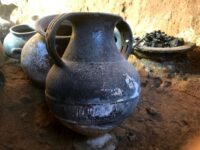 Vulci was a prosperous Etruscan city-state 50 miles northwest of Rome. It was the birthplace of the legendary sixth king of Rome, Servius Tullius (r. 578-535 B.C.) and an important center of ceramic arts, metal mining and metal crafts. It was also a center of trade, purveying expensive imports of Greek pottery, balms and unguents from the east.
Vulci was a prosperous Etruscan city-state 50 miles northwest of Rome. It was the birthplace of the legendary sixth king of Rome, Servius Tullius (r. 578-535 B.C.) and an important center of ceramic arts, metal mining and metal crafts. It was also a center of trade, purveying expensive imports of Greek pottery, balms and unguents from the east.
It was defeated by Rome in 280 B.C.; Roman forces took its coastal territory, cutting off Vulci’s access to the sea and strangling the maritime trade that had been so integral to its success. The city declined and was ultimately abandoned. No new town was ever built over it.
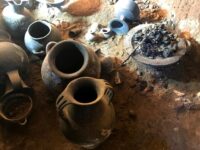 Part of it survived underground, however, in Vulci’s necropoli. Tens of thousands of tombs containing priceless artifacts from every day use objects to entire chariots and silver hands. An unpopulated area far from the prying eyes of any authorities with tons of unknown and unrecorded portable archaeological wealth made a perfect target for looters and over the decades Vulci has been re-sacked on a vast scale. The discovery of an intact, unlooted tomb with its contents complete and undamaged is therefore incredibly rare.
Part of it survived underground, however, in Vulci’s necropoli. Tens of thousands of tombs containing priceless artifacts from every day use objects to entire chariots and silver hands. An unpopulated area far from the prying eyes of any authorities with tons of unknown and unrecorded portable archaeological wealth made a perfect target for looters and over the decades Vulci has been re-sacked on a vast scale. The discovery of an intact, unlooted tomb with its contents complete and undamaged is therefore incredibly rare.
“Helike” (Ἑλίκη) was an ancient Greek city-state that was submerged by a tsunami in the winter of 373 BC, founded already in the Bronze Age. During the expansion, however, Helike founded several Mediterranean colonies: What became “Elche” in Spain, for example, (cf. “Dama de Elche”) originally had been named in the 7th century BC ‘Helíkē’ by them.
Our prosperous Etruscan city-state of “Vulci”, 50 miles northwest of Rome, notably was in Etruscan referred to as “Velch”(!), or “Velx”, i.e. just like their –hereby proposed– Spanish counterpart. What probably started as Minoan trading networks, later led to the establishment of “Magna Graecia” in what today is Southern Italy.
Of course, modern European non-Greek writing systems, like already the Etruscan one, are Phoenician influenced. Even the Greek one was, according to Herodotus (5.58) in the 5th century BC: “Now these Phoenicians (…) brought in among the Hellenes many arts when they settled (…), and especially letters, which did not exist, as it appears to me…”